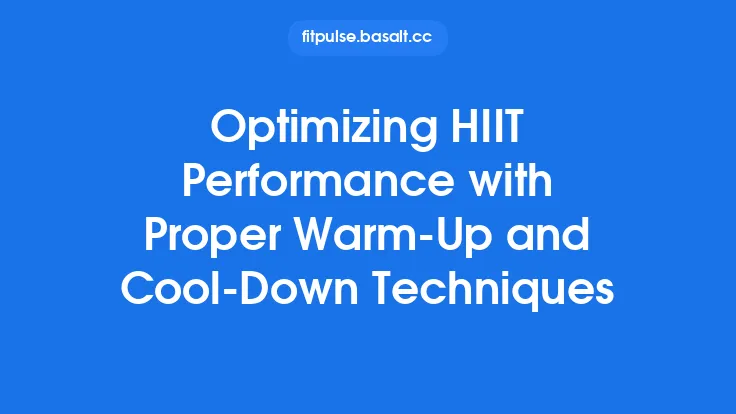When the temperature climbs and humidity hangs heavy in the air, the body’s usual cardio warm‑up routine can feel like a slow‑cooking furnace. Muscles, joints, and the cardiovascular system still need the same preparatory stimulus—gradual elevation of temperature, increased blood flow, and activation of neural pathways—but the surrounding environment forces us to rethink how we deliver that stimulus. By adjusting intensity, duration, movement selection, and environmental controls, you can preserve the protective benefits of a warm‑up while minimizing the added strain that heat and humidity impose on the body.
Understanding the Physiological Challenges of Heat and Humidity
Thermoregulation under stress – In hot, humid conditions the skin’s ability to dissipate heat through sweat evaporation is compromised. The ambient temperature may already be close to, or even exceed, skin temperature, reducing the temperature gradient that drives heat loss. As a result, core temperature rises more quickly during activity, and the cardiovascular system must work harder to pump blood to the skin for cooling.
Cardiovascular drift – Even at a steady workload, heart rate tends to climb over time in the heat, a phenomenon known as cardiovascular drift. This occurs because a larger proportion of cardiac output is diverted to the skin, leaving less for the working muscles. If the warm‑up itself pushes heart rate too high, the subsequent cardio session may start with an already elevated baseline, shortening the window for optimal performance.
Neuromuscular fatigue – Elevated muscle temperature is beneficial for power and elasticity, but excessive heat can impair motor unit recruitment and increase the perception of effort. The combination of heat‑induced dehydration (even mild) and electrolyte shifts can also affect muscle excitability, leading to premature fatigue.
Sweat rate and fluid balance – Humidity slows sweat evaporation, meaning the body may produce large volumes of sweat that linger on the skin, feeling clammy and heavy. This can alter proprioception and increase the risk of slipping during dynamic movements.
Understanding these mechanisms helps you target the warm‑up’s goals—raising muscle temperature, enhancing joint lubrication, and priming the nervous system—while avoiding unnecessary cardiovascular load and thermal stress.
Core Principles for Modifying Your Warm‑Up
- Prioritize gradual thermal elevation – Increase muscle temperature in small, controlled increments rather than a single high‑intensity burst.
- Limit cardiovascular strain – Keep heart rate within a modest range (typically 50‑60 % of maximum) during the warm‑up to preserve reserve for the main cardio session.
- Emphasize dynamic mobility – Use movement patterns that promote joint range of motion without excessive metabolic demand.
- Incorporate environmental control where possible – Shade, wind, or brief periods of air‑conditioned space can offset ambient heat without compromising the warm‑up’s purpose.
- Monitor internal cues – Rely on perceived exertion, skin temperature, and heart‑rate feedback to adjust intensity on the fly.
Applying these principles yields a warm‑up that respects the body’s thermoregulatory limits while still delivering the physiological priming needed for safe, effective cardio work.
Dynamic Movements Tailored for Hot Conditions
| Movement | Target | Modification for Heat |
|---|---|---|
| Leg swings (front‑to‑back & side‑to‑side) | Hip flexors, extensors, abductors | Perform at a controlled tempo (2 sec up, 2 sec down) to keep heart rate low. |
| Walking lunges with torso twist | Quadriceps, glutes, thoracic spine | Reduce stride length and add a brief pause at the bottom to limit metabolic demand. |
| High‑knee march | Hip flexors, calves, core activation | Keep the knee lift to ~70 % of maximal height; focus on ankle dorsiflexion rather than speed. |
| Arm circles (small to medium) | Deltoids, scapular stabilizers | Execute slowly (3‑4 sec per rotation) to avoid excessive upper‑body pumping. |
| Dynamic calf stretch (heel‑to‑toe walk) | Gastrocnemius, soleus | Perform on a shaded surface; limit the number of repetitions to 10‑12 per leg. |
| Cat‑cow spinal mobilization | Lumbar and thoracic mobility | Use a breathing cue (inhale for cow, exhale for cat) to integrate diaphragmatic control without raising heart rate. |
These movements collectively raise joint temperature, lubricate synovial fluid, and activate the neuromuscular pathways needed for cardio without imposing a high aerobic load. The key is to keep the tempo moderate and the range of motion purposeful.
Adjusting Duration and Intensity
Traditional warm‑up length – In temperate conditions, a 10‑15 minute warm‑up that progresses from low‑intensity activity to moderate effort is common.
Hot‑weather adaptation – Reduce the overall duration by 20‑30 % (e.g., 7‑10 minutes) while ensuring each movement is performed with full range. The shorter window limits cumulative heat gain.
Intensity scaling – Use the “talk test” or a Rating of Perceived Exertion (RPE) of 2‑3 on a 10‑point scale. If you have a heart‑rate monitor, aim for 50‑60 % of age‑predicted maximum (220 – age). For a 35‑year‑old, that translates to roughly 95‑115 bpm.
Progression pattern – Begin with a low‑impact activity (e.g., brisk walk or easy jog) for 2‑3 minutes, then transition to the dynamic mobility circuit for another 4‑5 minutes. Finish with a brief, sport‑specific movement (e.g., a few easy strides or a short interval at 60 % effort) to bridge the warm‑up to the main cardio set.
By compressing time and capping intensity, you achieve the necessary physiological priming while leaving a larger thermal reserve for the upcoming workout.
Incorporating Controlled Breathing and Core Activation
Breathing rhythm – In humid air, each breath feels heavier. Encourage diaphragmatic breathing with a 2:2 inhale‑exhale pattern during dynamic movements. This stabilizes intra‑abdominal pressure, supports lumbar spine alignment, and reduces the perception of breathlessness.
Core bracing – Light core engagement (e.g., gentle abdominal hollowing) during leg swings and lunges improves postural stability, which is especially valuable when sweat makes footing slippery.
Integration tip – Pair each movement with a breathing cue: “Inhale as you swing the leg forward, exhale as you return.” This synchrony keeps the cardiovascular load low and reinforces neuromuscular coordination.
Monitoring Internal Load: Heart Rate and Perceived Exertion
- Heart‑rate check – After the initial low‑intensity phase, pause for 30 seconds and note the heart‑rate reading. If it exceeds the target zone, reduce the tempo of the subsequent dynamic set.
- RPE scale – Ask yourself, “On a scale of 1–10, how hard am I working?” Aim for a rating of 2‑3. If you feel a 5 or higher, scale back.
- Skin temperature cue – A quick back‑of‑hand test can indicate excessive heat. If the skin feels hot to the touch (above 35 °C/95 °F), consider moving to a shaded spot or briefly stepping into a cooler area before proceeding.
Consistent monitoring allows you to stay within safe thermal limits and prevents the warm‑up from becoming a source of premature fatigue.
Pre‑Cool Strategies to Mitigate Heat Stress
Even before the warm‑up begins, a few simple pre‑cool tactics can lower core temperature by 0.2‑0.5 °C, providing a valuable buffer:
- Cold‑water splash – Lightly douse the face, neck, and wrists with cool water for 15‑20 seconds. These areas have high vascularity and can accelerate heat loss.
- Ice‑vest or cooling towel – If available, wear a thin cooling vest or wrap a chilled towel around the upper back for 3‑5 minutes. Remove it just before the warm‑up to avoid a sudden temperature drop.
- Shade exposure – Spend 5 minutes in a shaded or air‑conditioned space before stepping outside. This reduces ambient heat load without affecting muscle temperature.
These measures are brief enough not to interfere with the warm‑up’s purpose but effective at delaying the onset of cardiovascular drift.
Post‑Warm‑Up Cool‑Down and Transition
After the warm‑up, a short transition period (1‑2 minutes) helps the body shift from preparation to the main cardio effort:
- Gentle walking – A slow walk in the shade allows excess heat to dissipate gradually while maintaining blood flow to the muscles.
- Dynamic stretch hold – Hold each major joint stretch (hamstring, quadriceps, calf) for 10‑15 seconds without bouncing. This maintains flexibility without adding metabolic stress.
- Re‑assessment – Take a final heart‑rate and RPE reading. If the numbers are still within the warm‑up target range, you are ready to begin the cardio session. If they remain elevated, consider a brief additional cool‑down or a short rest before starting.
A smooth transition preserves the benefits of the warm‑up while ensuring you do not start the cardio workout already compromised by heat.
Practical Checklist for a Safe Hot‑Weather Warm‑Up
| Item | Action |
|---|---|
| Environment | Choose a shaded area or create temporary shade (umbrella, tree). |
| Pre‑cool | Splash face/neck with cool water; optional cooling towel for 3‑5 min. |
| Initial low‑intensity | 2‑3 min brisk walk or easy jog, keep HR ≤ 60 % max. |
| Dynamic circuit | Perform leg swings, walking lunges with twist, high‑knee march, arm circles, calf walk, cat‑cow – 4‑5 min total, RPE 2‑3. |
| Breathing | Diaphragmatic 2:2 inhale‑exhale pattern throughout. |
| Core | Light abdominal bracing on each movement. |
| Monitoring | Check HR and RPE after low‑intensity phase; adjust tempo if needed. |
| Transition | 1‑2 min gentle walk + brief static stretch. |
| Final check | HR ≤ 70 % max, RPE ≤ 4, skin feels comfortably warm, not hot. |
| Hydration reminder | Take a small sip of water (≈150 ml) before the main cardio set. |
By following this checklist, you can systematically adapt your warm‑up to the challenges of heat and humidity, safeguarding performance and reducing the risk of heat‑related issues.
Bottom line: In hot, humid environments the warm‑up’s role does not change—it still prepares muscles, joints, and the nervous system for cardio work. What does change is how you deliver that preparation. By shortening duration, moderating intensity, selecting low‑metabolic dynamic movements, integrating controlled breathing, and employing simple pre‑cool tactics, you can achieve a thorough warm‑up while preserving cardiovascular reserve and maintaining safe core temperatures. This balanced approach lets you enjoy effective cardio sessions all summer long, even when the mercury climbs.





